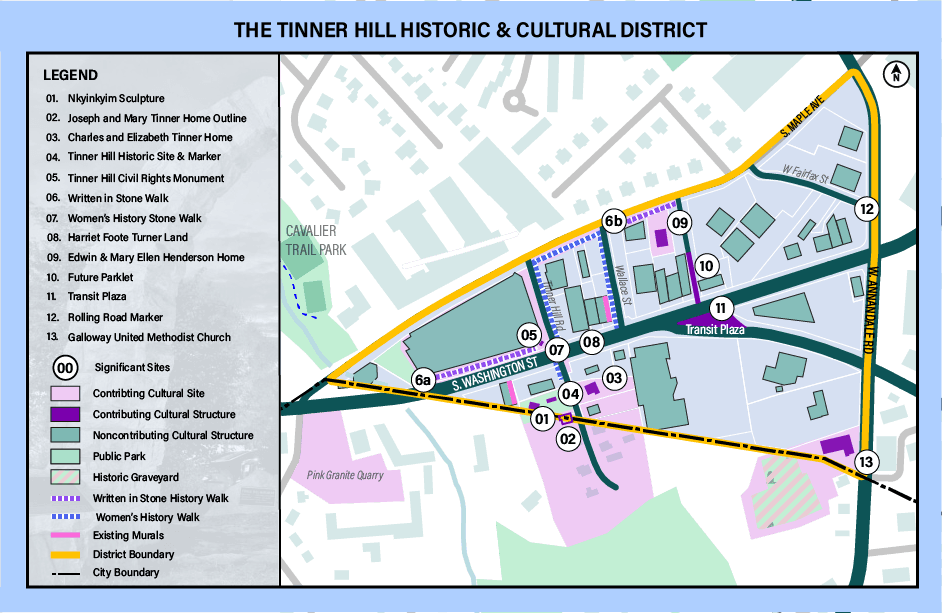
Tinner Hill Historic & Cultural District
At the heart of Tinner Hill stands the Tinner Hill Historic Site, a revered symbol of courage and activism. This site commemorates the founding of the first rural branch of the NAACP in 1915, a pivotal moment in the fight for civil rights. Through immersive exhibits and engaging programs, visitors can trace the footsteps of those who dared to dream of a more just and equitable society.
The Tinner Hill Historic Park is the site of the original home to Joseph and Elizabeth Tinner, the couple who fought segregation laws after the borders of neighbouring towns were redrawn, cutting directly through their thriving community. Their actions led to the first rural branch of the NAACP.
The property is located on a hill in the southernmost portion of Falls Church. Charles Tinner and his wife built their family home on this lot and subdivided the rest for their ten children to someday build on. These lots developed into the African American community of Tinner Hill. The Tinner Hill community represented early land and home ownership in the African American community of Falls Church.
CHARLES AND MARY ELIZABETH TINNER HOUSE (DEMOLISHED)
The Tinner Hill Historic & Cultural District recognizes the history and cultural heritage of the Tinner Hill community and its citizens.
THE HENDERSON HOUSE TODAY
Learn More about the History of Tinner Hill
-
Charles Tinner and his wife, Mary Elizabeth Tinner, were the founders of the Tinner Hill community. Charles, a local African American stone mason, purchased a lot in the southernmost portion of Falls Church. He subdivided the lot, creating ten different lots for his ten children to one day build on. These lots then developed into the Tinner Hill neighborhood.
-
The home of Joseph and Mary Tinner was once located at 106 - 108 Tinner Hill Road. Prior to the Civil War Era, the site on which the Tinner home sat was also home to enslaved people who worked on the nearby Dulany Plantation. Joseph Tinner, the son of Charles Tinner, was a leader in the Civil Rights Movement. Joseph Tinner was the President of the first rural chapter of the NAACP. The first meeting of this NAACP branch was held in his home on Tinner Hill. The Tinner Hill Historic Park now stands on the site previously occupied by the Tinner home.
-
A historic site, the former home of Dr. E. B. Henderson and Mary Ellen Henderson, is located at 307 S. Maple Ave. The home, along with the surrounding property, remains standing and is currently occupied by Dr. Lawrence T. and Mrs. Eleanor J. Henderson. Apart from minor upgrades like the addition of a carport, the house is the same Sears kit home built in 1913 and maintains its historic integrity.
The Henderson home, built in 1913 from a Sears kit, still stands today. The house has undergone some upgrades and modifications, including the addition of a carport. Originally, the house was built at the southern end of the lot and faced south. However, the construction of Lee Highway in 1922 necessitated its relocation further north to prevent damage. The road now bisected the Henderson property, leaving portions on either side. The house was turned to face north in 1950, likely to face away from the backs of commercial establishments that had sprung up between the house and Lee Highway. This change in orientation is reflected in a 1946 Sanborn map, which was probably altered to align with the 1950 change.
-
The fifteen-foot Tinner Hill Arch, erected by the Tinner Hill Heritage Foundation (a member of the Virginia African American Heritage Trail), honors the men and women of Tinner Hill who founded the first rural NAACP branch. Located at the corner of South Washington Street and Tinner Hill Road, the arch was constructed using pink granite (trondhjemite) originally quarried at the base of Tinner Hill by the Tinner family.
The stone used for the arch was collected over two years from Falls Church properties. When many stone buildings in Falls Church were destroyed in the mid-20th century, families used the remaining stones to build walls in their yards. Over 30 Falls Church property owners generously donated these stones for the monument.
The Nkyinkyim (Zig Zag) Sculpture follows the original location of the segregation line. Particularly striking is the “Zig-Zag” sculpture by local artist Martha Jackson Jarvis, which represents how political leaders drew boundaries to dilute the voting power of local Black residents in 1887.
The line placed many Black residents in much larger Fairfax County, instead of the small city of Falls Church. In a large county, the Black vote would carry little weight. Interestingly, the zig-zag is also a West African symbol, which means to perform the unusual or impossible.
Sites included in the Tinner Hill Historic & Cultural District:
Charles and Mary Elizabeth Tinner House
Galloway Methodist Church (cemetery in Fairfax County)
Joseph and Mary Tinner Home Outline (demolished)
The Henderson House
The Tripp Quarry – Trondhjemite (in Fairfax County)
Nkyinkyim (Zig Zag) Sculpture
Tinner Hill Civil Rights Monument
Tinner Hill Historic Site Marker
Written in Stone Walking Trail
Women’s History Walk
Harriet Foote Turner Land
Future Parklet (410 S Washington Street)
Transit Plaza
Rolling Road Marker







